In this guide, we will walk you step-by-step on how you can install a Kubernetes (k8s) cluster on RHEL 8. We will demonstrate this using one Master and one worker node which we will add to our cluster.
Also known as k8s, Kubernetes is an opensource, and portable container orchestration platform for automating the deployment and management of containerized applications. Kubernetes was originally created by Google in the Go programming language. Currently, it is maintained by Cloud Native Computing Foundation.
Lab setup
- Master node: master-node-k8 192.168.1.130
- Worker node: worker-node-1-k8 192.168.1.140
NOTE: Steps 1 to 6 should be applied to both the Master and the worker node.
Step 1) Disable swap space
For best performance, Kubernetes requires that swap is disabled on the host system. This is because memory swapping can significantly lead to instability and performance degradation.
To disable swap space, run the command:
$ sudo swapoff -a
To make the changes persistent, run
$ sudo sed -i '/ swap / s/^\(.*\)$/#\1/g' /etc/fstab
Step 2) Disable SELinux
Additionally, we need to disable SELinux and set it to ‘permissive’ in order to allow smooth communication between the nodes and the pods.
To achieve this, open the SELinux configuration file.
$ sudo vi /etc/selinux/config
Change the SELINUX value from enforcing to permissive.
SELINUX=permissive
Alternatively, you use the sed command as follows.
$ sudo sed -i 's/^SELINUX=enforcing$/SELINUX=permissive/' /etc/selinux/config
Step 3) Configure networking in master and worker node
Some additional network configuration is required for your master and worker nodes to communicate effectively. On each node, edit the /etc/hosts file.
$ sudo vi /etc/hosts
Next, update the entries as shown
192.168.1.130 master-node-k8 192.168.1.140 worker-node-1-k8
Save and exit the configuration file. Next, install the traffic control utility package:
$ sudo dnf install -y iproute-tc
Step 4) Allow firewall rules for k8s
For seamless communication between the Master and worker node, you need to configure the firewall and allow some pertinent ports and services as outlined below.
On Master node, allow following ports,
$ sudo firewall-cmd --permanent --add-port=6443/tcp $ sudo firewall-cmd --permanent --add-port=2379-2380/tcp $ sudo firewall-cmd --permanent --add-port=10250/tcp $ sudo firewall-cmd --permanent --add-port=10251/tcp $ sudo firewall-cmd --permanent --add-port=10252/tcp $ sudo firewall-cmd --reload
On Worker node, allow following ports,
$ sudo firewall-cmd --permanent --add-port=10250/tcp $ sudo firewall-cmd --permanent --add-port=30000-32767/tcp $ sudo firewall-cmd --reload
Step 5) Install CRI-O container runtime
Kubernetes requires a container runtime for pods to run. Kubernetes 1.23 and later versions require that you install a container runtime that confirms with the Container Runtime Interface.
A Container Runtime is an application that supports running containers. Kubernetes supports the following Container Runtime:
- Containerd
- CRI-O
- Docker Engine
- Mirantis Container Runtime
In this guide, we will install CRI-O which is a high-level container runtime. To do so, we need to enable two crucial kernel modules – overlay and br_netfilter modules.
To achieve this, we need to configure the prerequisites as follows:
First, create a modules configuration file for Kubernetes.
$ sudo vi /etc/modules-load.d/k8s.conf
Add these lines and save the changes
overlay br_netfilter
Then load both modules using the modprobe command.
$ sudo modprobe overlay $ sudo modprobe br_netfilter
Next, configure the required sysctl parameters as follows
$ sudo vi /etc/sysctl.d/k8s.conf
Add the following lines:
net.bridge.bridge-nf-call-iptables = 1 net.ipv4.ip_forward = 1 net.bridge.bridge-nf-call-ip6tables = 1
Save the changes and exit. To confirm the changes have been applied, run the command:
$ sudo sysctl --system
To install CRI-O, set the $CRIO_VERSION environment variable to match your CRI-O version. For instance, to install CRI-O version 1.30 set the $CRIO_VERSION as shown:
$ export CRIO_VERSION=v1.30
Next, run the following command to add crio repository.
$ cat <<EOF | sudo tee /etc/yum.repos.d/cri-o.repo [cri-o] name=CRI-O baseurl=https://pkgs.k8s.io/addons:/cri-o:/stable:/$CRIO_VERSION/rpm/ enabled=1 gpgcheck=1 gpgkey=https://pkgs.k8s.io/addons:/cri-o:/stable:/$CRIO_VERSION/rpm/repodata/repomd.xml.key EOF
Then use the DNF package manager to install CRI-O:
$ sudo dnf install -y cri-o

Next, enable CRI-O on boot time and start it:
$ sudo systemctl enable crio $ sudo systemctl start crio
Step 6) Install Kubernetes Packages
With everything required for Kubernetes to work installed, let us go ahead and install Kubernetes packages like kubelet, kubeadm and kubectl.
Set the Kubernetes version variable as shown below:
$ KUBERNETES_VERSION=v1.30
Next, create a Kubernetes repository file.
$ cat <<EOF | sudo tee /etc/yum.repos.d/kubernetes.repo [kubernetes] name=Kubernetes baseurl=https://pkgs.k8s.io/core:/stable:/$KUBERNETES_VERSION/rpm/ enabled=1 gpgcheck=1 gpgkey=https://pkgs.k8s.io/core:/stable:/$KUBERNETES_VERSION/rpm/repodata/repomd.xml.key EOF
Save the changes and exit. Finally, install k8s package as follows. At time of writing this guide, Kubernetes version 1.30 is available.
$ sudo dnf install kubelet kubeadm kubectl -y

Once installed, be sure to enable and start Kubelet service.
$ sudo systemctl enable kubelet $ sudo systemctl start kubelet
At this juncture, we are all set to install Kubernetes cluster.
Step 7) Create a Kubernetes cluster
We are going to initialize a Kubernetes cluster using the kubeadm command as follows. This initializes a control plane in the master node.
$ sudo kubeadm init --pod-network-cidr=192.168.10.0/16
Once the control plane is created, you will be required to carry out some additional commands to start using the cluster.
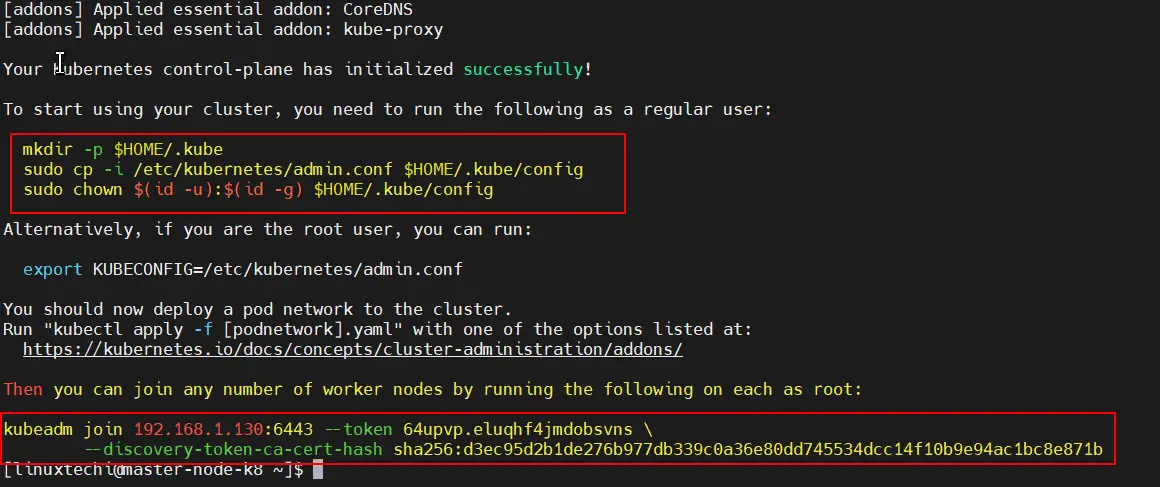
Therefore, run the commands, sequentially.
$ mkdir -p $HOME/.kube $ sudo cp -i /etc/kubernetes/admin.conf $HOME/.kube/config $ sudo chown $(id -u):$(id -g) $HOME/.kube/config
At the very end of the output, you will be given the command to run on worker nodes to join the cluster. We will come to that later in the next step.
Also, be sure to remove taints from the master node:
$ kubectl taint nodes --all node-role.kubernetes.io/master-
Step 8) Install Calico Pod Network Add-on
The next step is to install Calico CNI (Container Network Interface). It is an opensource project used to provide container networking and security. After Installing Calico CNI, nodes state will change to Ready state, DNS service inside the cluster would be functional and containers can start communicating with each other.
Calico provides scalability, high performance, and interoperability with existing Kubernetes workloads. It can be deployed on-premises and on popular cloud technologies such as Google Cloud, AWS and Azure.
To install Calico CNI, run the following command from the master node
$ kubectl apply -f https://raw.githubusercontent.com/projectcalico/calico/v3.28.0/manifests/calico.yaml
To confirm if the pods have started, run the command:
$ kubectl get pods -n kube-system
You should see that each pod is ‘READY’ and has the ‘RUNNING’ status as shown in the third column.

To verify the master node’s availability in the cluster, run the command:
$ kubectl get nodes NAME STATUS ROLES AGE VERSION master-node-k8 Ready control-plane 9m56s v1.30.4 $
In addition, you can retrieve more information using the -o wide options.
$ kubectl get nodes -o wide

The above output confirms that the master node is ready. Additionally, you can check the pod namespaces:
$ kubectl get pods --all-namespaces

Step 9) Adding worker node to the cluster
To add the worker node to the Kubernetes cluster, follow step 1 up until Step 6. Once you are done, run the command generated by the master node for joining a worker node to the cluster. In our case, this will be:
$ sudo kubeadm join 192.168.1.130:6443 --token 64upvp.eluqhf4jmdobsvns \ --discovery-token-ca-cert-hash sha256:d3ec95d2b1de276b977db339c0a36e80dd745534dcc14f10b9e94ac1bc8e871b
If all goes well, you should get the notification that the node has joined the cluster. Repeat the same procedure for other nodes in case you have multiple worker nodes
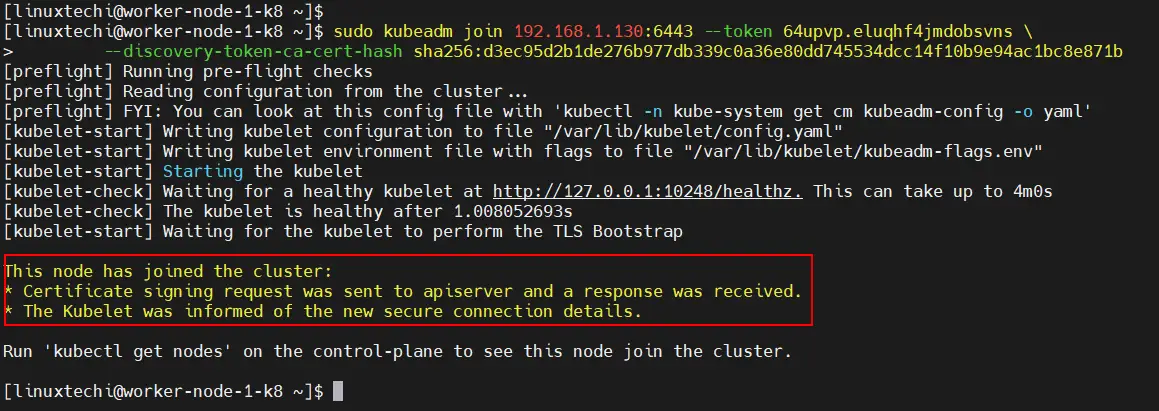
Now, head back to the master node and, once again, verify the nodes in your cluster. This time around, the worker node will appear in the list on nodes in the cluster,
$ kubectl get nodes

Conclusion
That was a walk through of how you can install a Kubernetes Cluster on RHEL 8. Your feedback on this guide is welcome.
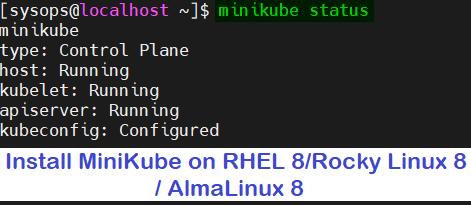
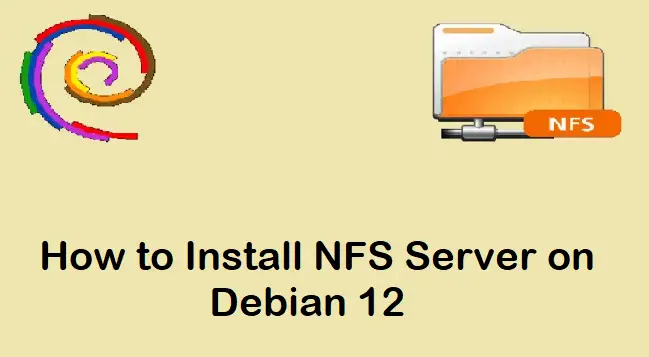
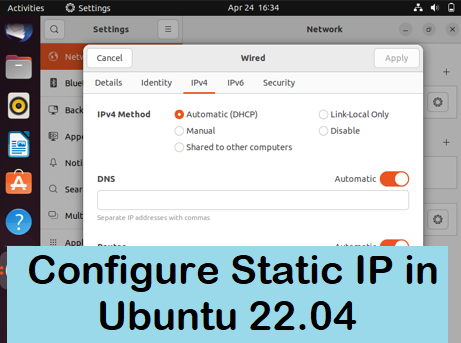
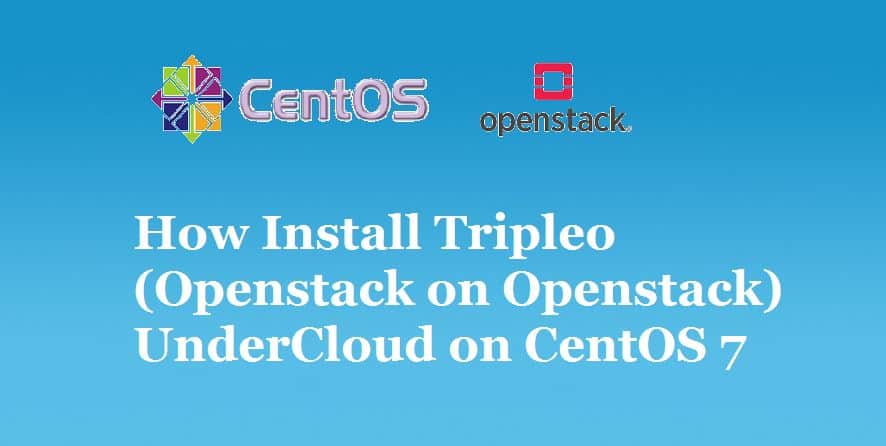
Hi
Pradeep Kumar
Currently I am deployed in Rocky Linux 8, I didn’t have any problem or single point failure during this installation. Lovely stuffs. Thanks.
Aneesh
Really good tutorial. I’ve found one mistake. In my case command “$ kubectl taint nodes –all node-role.kubernetes.io/master-” was incorrect. I believe the correct one is with “–all”
Good work.
Cheers.
Hi Dino,
It has been fixed now, thank you for letting me know.
you can use this cmd,
$ kubectl taint nodes --all node-role.kubernetes.io/control-plane-RPMs are not being found at the URL listed in the repo file as shown at this point. Any idea on alternate URLs where the RPMs might be found for the Kubernetes repo?
Thanks for that.
i have followed it exactly over and over but still getting this when initializing pod network:
sudo kubeadm init –pod-network-cidr=192.168.10.0/16
The connection to the server localhost:8080 was refused – did you specify the right host or port?
I have spent some times googling this. but all the suggested solution doesn’t solve mine.
Any thaugts?
Thanks a lots
I have success following your step for Rocky Linux 8.4 and Kubernetes 1.23.15 with bellow corrections:
Step 5) cri-o Unit cri-o.service not found -> must be changed to crio
Step 6) install k8s package will fail, see issues ‘https://github.com/cri-o/cri-o/issues/6197’, solution is change /etc/containers/policy.json and apply “keyPath”: “/etc/pki/rpm-gpg/RPM-GPG-KEY-redhat-release” instead of “keyPaths” as logged by error message
With Caution:
[kubelet-check] The HTTP call equal to ‘curl -sSL ‘http://localhost:10248/healthz” failed with error: Get ‘”http://localhost:10248/healthz”‘: dial tcp [::1]:10248: connect: connection refused.
Any suggestion?
Thank You Pradeep
This worked very well !!!
Great tutorial!
I went off script and I ran into an issue.
If using AlmaLinux or Rocky Linux, when running the kubeadm init on the master node. It looks like there is an issue with CRI-O.
‘https://github.com/cri-o/cri-o/issues/6197’
Set contents of /etc/containers/policy.json to:
{ “default”: [ { “type”: “insecureAcceptAnything” } ], “transports”: { “docker”: { “registry.access.redhat.com”: [ { “type”: “signedBy”, “keyType”: “GPGKeys”, “keyPath”: “/etc/pki/rpm-gpg/RPM-GPG-KEY-redhat-release” } ], “registry.redhat.io”: [ { “type”: “signedBy”, “keyType”: “GPGKeys”, “keyPath”: “/etc/pki/rpm-gpg/RPM-GPG-KEY-redhat-release” } ] }, “docker-daemon”: { “”: [ { “type”: “insecureAcceptAnything” } ] } } }
That resolved things for me, and kubeadm init was now able to download packages, without keypath error.
Also note to beginners CRI-O version must match kubernetes package versions.
You might need to specify to your specific version:
sudo dnf install -y kubelet-1.24.4-00 kubeadm-1.24.4-00 kubectl-1.24.4-00 –disableexcludes=kubernetes
Good Luck!!
Can you please share the step how to install metrics-server in k8s clusture
Hi,
We will create a post shortly on how to install metrics server on K8s
The first part of Step 8 is outdated. The link to the tigera operator does not exist anymore. The correct link should ‘https://raw.githubusercontent.com/projectcalico/calico/v3.25.0/manifests/tigera-operator.yaml’
Hi Kaitlyn,
Thanks for notifying the link error, I have updated the step 8 with correct link.
when i install crio and start the service. Here is the output error:
Job for crio.service failed because the control process exited with error code.
See “systemctl status crio.service” and “journalctl -xe” for details.
faced a similar challenge and I was able to start crio after I did yum update libseccomp